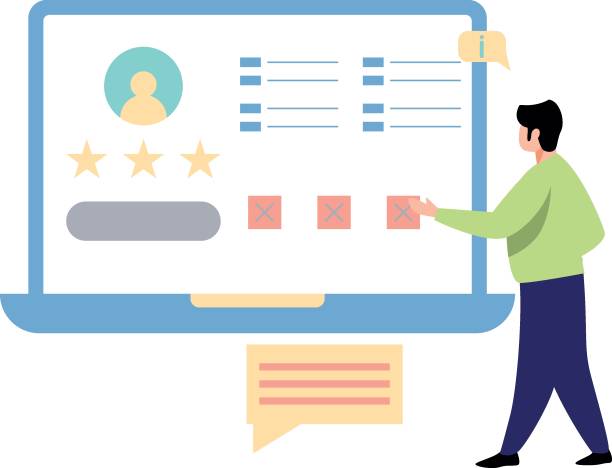The Importance of Multilingual Website Design in Today’s World

In the era of #Globalization and increased #Greater_Access to the internet, geographical boundaries for businesses have lost their former meaning.
Today, an online presence is not just an advantage but a necessity, and to reach #International_Audience, the concept of Multilingual Website Design has become more important than ever.
Single-language websites ignore a large portion of the global market potential and are limited to a small group of users.
Meanwhile, competition in digital markets is extremely high, and any business that wants to succeed in this arena must think beyond its linguistic borders.
Designing a website in multiple languages allows businesses to communicate with users worldwide in their native language.
This direct and personalized communication not only improves the user experience but also significantly helps increase brand trust and credibility.
A multilingual website provides a complete explanation of your products and services to audiences from different cultures and languages, allowing them to use your services with greater confidence.
This approach is, in fact, a bridge to enter emerging markets and capitalize on countless opportunities that previously seemed unattainable.
For example, a manufacturing company intending to export its products can, by implementing a multilingual website design, provide comprehensive product information in several living languages to potential customers and thereby advance its sales and marketing process more effectively.
This capability is crucial, especially in the current era where businesses are eagerly seeking to expand their scope of activity, and it enables companies to find and connect with their target audiences across the globe without geographical limitations.
Are you concerned about your e-commerce site’s low conversion rate and not achieving your desired sales?
Rasaweb is your specialized solution for a successful e-commerce site.
✅ Significant increase in conversion rates and sales
✅ Professional and user-friendly design to satisfy customers
⚡ Ready for a transformation in online sales? Get a free consultation!
Numerous Advantages of Having a Multilingual Website

Having a multilingual website goes beyond mere content translation; it’s a powerful strategy for #Market_Expansion, improving #International_SEO, and strengthening #User_Trust.
A detailed analysis of the advantages of this approach shows why investing in multilingual website design is essential for any business seeking global growth and development.
The first and most important advantage is expanding audience reach.
By providing content in different languages, you can connect with millions of new users worldwide who do not speak English or your website’s primary language.
This increased access means more visitors and, consequently, greater sales potential.
Furthermore, multilingual websites significantly improve international SEO rankings.
Search engines like Google prefer websites that offer high-quality, localized content in multiple languages.
Proper use of hreflang tags and appropriate URL structure for each language helps search engines identify different versions of your website and display them to the right users in regional search results.
This analytically increases your organic traffic and directs more potential customers to you.
Also, a multilingual website demonstrates your respect for different cultures and languages, which in itself leads to a sense of trust and loyalty among users.
When users can easily find the information they need in their native language, the likelihood of them engaging with your brand and converting into customers significantly increases.
These benefits not only boost sales but also enhance your brand’s international reputation, positioning you as an innovative, customer-centric company that values the needs of global users.
Proper implementation of multilingual website design is considered a strategic investment for the future of any business in global markets.
Technical and Structural Considerations in Multilingual Website Design

To successfully implement a multilingual website design, understanding #Technical_Considerations and #URL_Structure is of high importance.
Choosing an appropriate #Content_Management_System (CMS) that fully supports multilingual capabilities is the first step.
These considerations include how languages are managed, URL structure, and how to ensure that search engines can correctly index different language versions of your site.
Different approaches to URL structure exist, including subdomain, subfolder, and country-code top-level domain (ccTLD) for each country.
Choosing the right structure for addressing multilingual website pages is one of the important technical decisions that directly impacts international SEO and user experience.
For example, using subfolders (yourdomain.com/fa) is generally recommended for SEO because it transfers the main domain’s authority to different language versions.
Also, correct implementation of hreflang tags in HTML code or via a sitemap is crucial for informing search engines about the linguistic and regional versions of your content.
These tags help ensure that the appropriate content is displayed to users in the correct region and language.
In this process, selecting a strong CMS that has plugins or built-in capabilities for multilingual website design and translation management is very specialized and essential.
Many CMSs, such as WordPress with plugins like WPML or Polylang, provide this capability.
Additionally, other technical issues such as character encoding (UTF-8), site loading speed (which is important for users in different parts of the world), and #Default_Language capability for browsers and user settings should be considered.
The following guidance summarizes these considerations:
| Approach | Example | Advantages | Disadvantages |
|---|---|---|---|
| Subfolder | yourdomain.com/en/ |
Strong SEO, easy management, lower cost | Lack of clear geographical distinction |
| Subdomain | en.yourdomain.com |
Separate hosting possible, clear distinction | Slightly more complex SEO management, requires more maintenance |
| ccTLD (Country-code Top-Level Domain) | yourdomain.fr |
Best for regional SEO, high trust | High cost, more complex management, requires separate domain |
Content Strategy for Multilingual Websites

Content strategy in multilingual website design goes far beyond a simple #Quality_Translation.
To succeed in global markets, businesses must pay special attention to #Localization of content and thorough research into #Multilingual_Keywords.
Localization means adapting content to the culture, values, and expectations of local audiences, so that the content is not only linguistically correct but also appears completely natural and appealing culturally.
This process includes adjusting terminology, units of measurement, dates, currencies, images, and even colors to match the local audience’s taste.
One of the main challenges in this area is ensuring the accuracy and quality of translation.
Using native-speaking translators who specialize in your field of activity is crucial to avoid machine or unprofessional translations that could damage your brand’s reputation.
Furthermore, keyword research for each language should be conducted separately, considering cultural differences and search behaviors in each region.
A keyword popular in one language or culture may have a different meaning in another language or culture, or may not be searched for at all.
This educational approach helps you produce content that is both linguistically correct and ranks high in local search engines.
For example, if your website promotes a home appliance product, you must ensure that technical terms and product names are translated correctly into different languages, adhering to local standards.
Also, the tone of writing should align with the cultural expectations of the audience.
This comprehensive content strategy helps your multilingual website be recognized as a credible and reliable source in every market and establish a deeper connection with your audience.
Therefore, multilingual website design is not just a technical project but also a strategic content project.
Does your current e-commerce site design lead to losing customers and sales?
Rasaweb is your solution with modern and user-friendly e-commerce website designs!
✅ Significantly increase conversion rates and sales
✅ Build strong branding and gain customer trust
⚡ Get a free e-commerce website design consultation from Rasaweb!
Search Engine Optimization (SEO) for Multilingual Websites

Search Engine Optimization (SEO) for multilingual websites has its own complexities, which go beyond the SEO of a single-language website.
Focusing on #International_SEO and correct use of #Hreflang_Tag is of high importance.
The main goal is for search engines to show the appropriate version of your website to users in the relevant region and language.
This process includes the precise use of hreflang tags, as previously mentioned, to point to alternative versions of each page for different languages and regions.
Incorrect use of these tags can lead to duplicate content issues and incorrect display in search results.
In addition to hreflang, #Site_Speed and content hosting also play a vital role in multilingual SEO.
Choosing web hosting servers close to your target audience can improve website loading speed, which is an important factor in SEO ranking and user experience.
Internal linking between different language versions can also help search engines better understand your website’s structure.
Furthermore, building a strong and relevant backlink profile in each language or region also helps improve rankings.
This specialized process requires continuous guidance and monitoring of SEO performance in each market.
Tools like Google Search Console and Google Analytics are essential for monitoring traffic and rankings in different regions.
By correctly implementing these strategies, your multilingual website can effectively compete in international markets and attract significant organic traffic.
Therefore, multilingual website design without a strong SEO strategy will not be complete, and your investment will not yield optimal returns.
Optimal User Experience (UX) in Multilingual Website Design

User Experience (UX) plays a pivotal role in multilingual website design.
A multilingual website must provide #Easy_Navigation both visually and functionally for all users, regardless of their language.
One key aspect is placing a clear and accessible #Language_Switcher in a strategic and standard location, such as the website header.
This option should be designed so that users can easily select their preferred language, even if their browser is not set to that language.
Also, the design should prevent sudden language changes or loss of user progress in forms or shopping carts.
Visual design considerations are also very important in multilingual UX.
Another explanation regarding this is that fonts must support character sets of all supported languages and have high readability.
For example, languages like Arabic or Persian, which are written from right to left, require specific CSS adjustments for the page layout to shift correctly.
Images and graphics should be universal or localized to be understandable and appropriate for all cultures.
This means avoiding images or symbols that might be offensive or confusing in some cultures.
A key guidance is to consider multilingual users throughout all design and development processes.
User testing with native-speaking participants from each target region can help identify weaknesses and improve UX.
The ultimate goal is for every user, regardless of their language, to feel that the website was designed for them and that they can easily find the information they need and interact with it.
This significantly helps increase conversion rates and customer loyalty.
Multilingual website design, in essence, is designing for everyone.
Popular Tools and Platforms for Implementing Multilingual Website Design

In today’s world, numerous tools and platforms exist to facilitate multilingual website design, each with its own advantages and disadvantages.
Choosing the most suitable tool depends on the specific project needs, budget, and technical capabilities of your team.
Among the most popular options are Content Management Systems (CMS) like #WordPress_Plugins, Drupal, and Joomla, which offer multilingual capabilities using specialized plugins or modules.
WordPress, due to its popularity and high flexibility, with plugins such as WPML and Polylang, has become one of the main choices for building multilingual websites.
WPML (WordPress Multilingual Plugin) is one of the most powerful and comprehensive multilingual tools for WordPress, enabling the translation of posts, pages, categories, tags, and even themes and plugins.
This specialized tool is designed for developers and professional users and fully supports multilingual SEO capabilities.
Polylang is another popular WordPress plugin that offers a lighter and simpler approach to language management, suitable for smaller projects or users looking for an easier solution.
On the other hand, platforms like Drupal and Joomla, with their built-in modules or specific plugins, provide the ability to create complex multilingual websites and are often used for larger enterprise projects.
The good news is that many of these Management_Systems and Translation_Tools are constantly being updated, offering new features such as AI-powered automatic translation or team collaboration capabilities.
The correct choice of these platforms plays a key role in the success of multilingual website design projects.
This is very important news for individuals planning to enter global markets.
| Plugin Name | Key Features | User Level | Cost |
|---|---|---|---|
| WPML | Full content translation (post, page, theme), advanced SEO, compatibility with many plugins | Intermediate to Advanced | Annual payment (Paid) |
| Polylang | Translation of posts, pages, categories, and tags, simple user interface | Beginner to Intermediate | Free (also has a Pro version) |
| GTranslate | Automatic machine translation, search engine SEO | Beginner | Free (also has a Pro version) |
Common Challenges and Smart Solutions in Multilingual Design

Implementing a multilingual website design, despite its numerous advantages, also presents its own challenges.
These challenges include #Translation_Management, ongoing #Technical_Support, and estimating the #Required_Budget.
One of the biggest obstacles is ensuring the quality and accuracy of translations.
Poor translation can damage brand credibility and even lead to cultural misunderstandings.
To overcome this challenge, it is essential to use native-speaking translators who specialize in the relevant field, and to utilize Translation Management Systems (TMS) that enable collaboration and review.
Another challenge is managing up-to-date and consistent content across all languages.
As new languages are added, maintaining and updating content can become complex.
A Challenging content question in this regard is: “How can we ensure that all language versions of the website are always consistent and up-to-date?” The solution is to use a CMS with strong multilingual capabilities that allows for centralized content management and translation workflows.
Additionally, issues related to multilingual SEO, including correct implementation of hreflang tags and management of regional URLs, require specialized technical knowledge.
To solve this problem, collaboration with international SEO specialists or training the internal team in this area is recommended.
Finally, budget and timing are also considerations.
Multilingual website design is an investment, and sufficient budget must be allocated for quality translation, technical development, and ongoing maintenance.
With careful planning and anticipating challenges, these obstacles can be turned into opportunities, leveraging the full potential of global markets.
Smart solutions include using frameworks developed to support multilingualism from the outset, as well as investing in automated translation and content management tools.
Does your current e-commerce site design lead to losing customers and sales?
Rasaweb, with its modern and user-friendly e-commerce website designs, is your solution!
✅ Significantly increase conversion rates and sales
✅ Build strong branding and gain customer trust
⚡ Get a free e-commerce website design consultation from Rasaweb!
Successful Multilingual Website Design Examples and Lessons Learned

Reviewing #Case_Studies of #Global_Brands that have successfully utilized multilingual website design capabilities can be inspiring and engaging.
Companies like IKEA, Airbnb, and Spotify are all clear examples of successful multilingual websites that have managed to attract millions of users worldwide by providing a localized user experience.
These brands have not only translated their content but also adapted it to the cultures and local needs of each market.
For example, IKEA’s regional websites, in addition to language translation, also pay attention to product diversity and local pricing.
One of the lessons learned from these success_story is the importance of deep localization.
This means going beyond word-for-word translation and truly understanding the cultural differences, dialects, and even humor in each region.
Airbnb, as a travel platform, has understood this well and not only offers its website in dozens of languages but also localizes its content to attract local audiences and showcase popular destinations in each country.
Spotify, alongside translating the user interface, adjusts podcast content and music playlists based on cultural preferences and popular artists in each region.
This approach helps multilingual website design not only transmit information but also establish an emotional connection with users.
Another lesson is investing in management tools and teams that can efficiently manage the process of updating and maintaining multilingual content.
These companies have shown that success in global markets requires a commitment to providing an unparalleled user experience in every language and culture, and this commitment necessitates continuous investment in the technical and content aspects of multilingual website design.
The Future of Multilingual Website Design and Emerging Trends

The future of multilingual website design will undergo significant changes with the emergence of new technologies, especially in the field of #Artificial_Intelligence and #Machine_Translation.
These trends promise greater ease and efficiency in the localization process and the delivery of multilingual content.
Recent advancements in deep learning and natural language processing have brought machine translation quality to a level where it can be used as a powerful complementary tool alongside human translation, especially for large volumes of content or non-sensitive content.
One important trend is the shift towards #Personalized_Experience.
In the future, websites will be able to not only change the language based on user preferences but also personalize content based on geographical location, past behavior, and even the user’s cultural tone.
This approach involves a deeper analytical approach to user data and the use of AI algorithms to deliver more relevant and engaging content.
Furthermore, with the growth of voice search and smart assistants, multilingual website design must consider optimizing for voice queries in different languages.
This means understanding how people speak and using natural language in content, not just written keywords.
Blockchain and Web3 may also play an important role in the future by creating decentralized systems for multilingual content management that provide greater transparency and security.
These trends indicate that multilingual website design is moving towards becoming smarter and providing a completely localized experience, which ultimately helps businesses establish more effective communication with their global audiences and optimize their online presence.
Investing in these emerging technologies is essential for maintaining competitiveness in the future.
Frequently Asked Questions
| Question | Answer |
|---|---|
| What is a multilingual website? | A website whose content is available to users in more than one language. |
| Why should I make my site multilingual? | To reach a wider audience in global markets, improve user experience, and enhance international SEO. |
| What are the technical approaches to building a multilingual site? | Using subdirectories, subdomains, or URL parameters to differentiate languages. |
| How does multilingual design impact SEO? | By targeting local keywords and providing content in users’ native languages, the site’s ranking in search engines for those regions improves. |
| What are the challenges of multilingual website design? | Content translation management, supporting Right-to-Left (RTL) direction, technical issues related to language addressing, and maintaining design consistency. |
| How do we choose the languages for a multilingual site? | Based on target audience analysis, target markets, and current site traffic data (if available). |
| What is RTL support and why is it important for some languages? | Right-to-Left, the direction of text and page elements from right to left, which is essential for languages like Persian, Arabic, and Hebrew. |
| How do we manage multilingual site content? | Using Content Management Systems (CMS) with multilingual capabilities, translation plugins, or professional translation services. |
| How is the user experience (UX) in a multilingual site? | The ability to easily switch languages should be provided, and translated content must be of high quality to ensure users feel comfortable. |
| Which are the common CMS platforms for multilingual sites? | WordPress (with plugins like WPML), Joomla, Drupal, and Shopify (with relevant settings or plugins). |
And other services of Rasaweb Advertising Agency in the field of advertising
Smart Direct Marketing: A creative platform for improving online growth with intelligent data analysis.
Smart Social Media: A professional solution for analyzing customer behavior with a focus on intelligent data analysis.
Smart Website Development: A dedicated service for digital branding growth based on attractive UI design.
Smart Content Strategy: A creative platform for improving digital branding using real data.
Smart Marketing Automation: Professional optimization for increasing sales using custom programming.
And over hundreds of other services in the field of online advertising, advertising consultation, and organizational solutions
Internet Advertising | Advertising Strategy | Advertorials
Sources
Multilingual Website Design: The First Step to Global Markets
Numerous Advantages of Multilingual Website Design
International SEO and Attracting Global Audience with Multilingual Site
Why Multilingual Website Design is Crucial?
? Are you ready to transform your business in the digital world? Rasaweb Afarin Digital Marketing Agency, with expertise in responsive website design, SEO, and online campaign management, is your comprehensive solution for growth and visibility. For consultation and taking big steps towards success, contact us today.
📍 Tehran, Mirdamad Street, next to Bank Markazi, Southern Kazeroon Alley, Ramin Alley, No. 6




